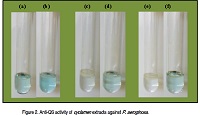The effect of Cyclamen coum extract on pyocyanin production by Pseudomonas aeruginosa
Keywords:
Pseudomonas aeruginosa, Cyclamen coum, Pyocyanin, Antimicrobial activityAbstract
Researches have shown that some plants possess antimicrobial activity and the ability to overcome drug-resistant pathogens. Their frequent used in treatment of microbial infections has been led to isolation of the active compounds and evaluation of their antimicrobial properties. Cyclamen coum Miller is one of these plants with a secondary metabolite called saponin which has antimicrobial activity. Pyocyanin is one of the virulence factors in Pseudomonas aeruginosa, an opportunistic pathogen, causing lung diseases. The present study indicates the effect of cyclamen saponin extracts on pyocyanin production by P. aeruginosa. We prepared three different types of plant extracts (ethanolic, aqueous and butanolic) from tuber of C. coum. The effect of 0, 10 and 20 mg of cyclamen saponin were tested by agar disk diffusion technique. Pyocyanin purification was done from microbial broth culture and the extracted pyocyanin was measured by spectrophotometric method. Results showed that the production of pyocyanin was remarkably reduced by ethanolic extract of saponin. In addition increased saponin concentration led to further decrease in pyocyanin content.
References
. Rojas A, Hernandez L. PeredaMiranda, R.; Mata, R. Screening for
antimicrobial activity of crude drug
extracts and purenatural products from
Mexican medicinal plants. J.
Ethnopharmacol. 1992, 35(3), 275-283.
. Quinlan MB, Quinlan RJ, Nolan JM.
Ethnophysiology and herbal treatments
of intestinal worms in Dominica, West
Indies. J. Ethnopharmacol. 2002,
(1):75-83.
. Nascimento GGF, Locatelli J, Freitas
PC, Silva GL. Antibacterial activity of
plant extracts and phytochemicals on
antibiotic-resistantbacteria. Braz. J.
Microbiol. 2000, 31: 247-256.
. Tanaka JCA, da Silva CC, de Oliveira
AJB, Nakamura CV Dias Filho BP.
Antibacterial activity of indole alkaloids
from Aspidosperma ramiflorum. Braz.
J. Med. Biol. Res. 2006, 39(3): 387-
. Cross A, Allen J R, Burke J, Ducel G,
Harris A, John J, Johnson D, Lew M,
MacMillan B, Skalova R, Wenzel R,
Tenney J. Nosocomial infections due
to Pseudomonas aeruginosa: review of
recent trends. Rev. Infect. Dis. 1983, 5
Suppl. 5:S837-45.
. Hewitt LF. Oxidation-reduction
potentials in bacteriology and
biochemistry, 6th ed., 1950.
. Mavrodi DV, Thomashow LS.
Functional Analysis of Genes of
Biosynthesis of Pyocyanin and
Phenazine-1-Carboxamide from
Pseudomonas aeruginosa PA01. J.
Bacteriol. 2001, 21, 6454-6465.
. Schauder SL, Bassler B. The
languages of bacteria. Genes Dev.
, 15: 1468-1480.
. Fuqua C, and Greenberg EP. Listening
in on bacteria: acyl-homoserine lactone
signalling. Nat. Rev. Mol. Cell Biol.
, 3, 685ă695.
. Whitehead NA, Barnard AM, Slater H,
Simpson NJ, Salmond GP. Quorum
sensing in Gram-negative bacteria.
FEMS Microbiol. Rev. 2001, 25, 365ă
. O'Loughlin CT, Miller LC, Siryaporn A,
Drescher K, Semmelhack MF, Bassler
BL. A quorum-sensing inhibitor blocks
Pseudomonas aeruginosa virulence
and biofilm formation. Proc.Natl. Acad.
Sci. U S A. 2013, 110(44):17981-6.
. Lyczak JB, Cannon CL, Pier GB. Lung
infections associated with cystic
fibrosis. Clin. Microbiol. Rev. 2002, 15,
ă222.
. Huerta V, Mihalik K, Crixell S H, Vattem
DA. Spices and medicinal plants used
in hispanic traditional medicine can
decrease quorum sensing dependent
virulence in Pseudomonas aeruginosa.
I. J. A. R. N. P. 2008, 1(2): 9-15.
. Çaliû I, úatana ME, Yürüker A, Kelican
P, Demirdamar R, Alaçam R, Tanker N,
Rüegger H, Sticherr O. Triterpene
saponins from Cyclamen mirabile and
their biological activities. J. Nat. Prod.
, 60(3):315-318.
. Liu J, Henkel T. Traditional Chinese
medicine (TCM): are polyphenols and
saponins the key ingredients triggering
biological activities? Curr. Med. Chem.
9(15):1483-5.
. Altunkeyik H, Gulcemal D, Masullo M.
Alankus-Caliskan, O.; Piacente, S.;
Karayildirim, T. Triterpene saponins
from Cyclamen hederifolium.
Phytochemistry. 2012. 73:127-133.
. Arslan S, Ozgun O, Celik G, Semiz A,
Dusen, O.; Mammadov, R.; Sen, A.
Effects of Cyclamen trochopteranthum
on hepatic drug metabolizing enzymes.
Arch. Biol. Sci. 2011. 63 (3):545-555.
. Arabski M, WŇgierek-Ciuk A,
Czerwonka G, Lankoff A, Kaca W.
Effects of saponins against clinical E.
coli strains and eukaryotic cell Line. J.
Biomed. Biotechnol. 2012. 2012, 1-6.
. Doøan N M, Mammadov R Düûen O,
Doøan G, Acar G, Evgen E. In vitro
antibacterial activity of Urginea
maritima, Cyclamen alpinum (C.
trochopteranthum), Cyclamen mirabile
and Crocus antalyensis.1st
international symposium on secondary
metabolites Denizli Turkey. 2011, 90.
. Azaizeh H, Saad B, Khalil K, Said O.
The State of the art of traditional Arab
herbal medicine in the eastern region
of the Mediterranean: A Review. Evid.
Based Complement. Alternat. Med.
3(2): 229-235.
. Alice CB, Vargas, VMF, Silva GAAB,
de Siqueira NCS Schapoval EES
Gleye J, Henriques JAP, Henriques,
A.T. Screening of plants used in south
Brazilian folk medicine. J.
Ethnopharmacol. 1991. 35:165-171.
. Källersjö M, Bergqvist G, Anderberg A
A. Generic Realignment in Primuloid
Families of the Ericales S.L.: A
Phylogenetic Analysis Based on DNA
Sequences from Three Chloroplast
Genes and Morphology. Am. J. Bot.
87 (9): 1325ă41.
. Salie F, Eagles PFK, Lens HMJ.
Preliminary antimicrobial screening of
four South African Asteraceae species.
J. Ethnopharmacol. 1996. 52(1): 27-33.
. Cox CD. Role of pyocyanin in the
acquisition of iron from transferrin.
Infect. immun. 1986. 52(1): 263-270.
. Sánchez P, Linares J F, Ruiz-Díez B,
Campanario E, Navas A, Baquero F,
Martínez JL, Fitness of in vitro selected
Pseudomonas aeruginosa nalB and
nfxB multidrug resistant mutants. J.
Antimicrob. Chemother. 2002. 50:657ă
. Clare DA, Duong MN, Darr D,
Archibald F. Fridovich, I. Effects of
molecular oxygen on the detection of
superoxide radical with
nitrobluetetrazolium and an activity
stain for catalase. Anal. Biochem.
140:532-537.
. Priya K, Yin WF, Chan KG. Antiquorum sensing activity of the
traditional Chinese herb, Phyllanthus
amarus. Sensors. 2013. 13:14558-
. Tan LY, Yin WF, Chan K G. Silencing
Quorum Sensing through Extracts of
Melicope lunu-ankenda. Sensors.
12:4339-4351.
. Koh CL, Sam CK, Yin WF, Tan L Y,
Krishnan T, Chong Y M, Chan KG.
Plant-Derived Natural Products as
Sources of Anti-Quorum Sensing
Compounds: A Review. Sensors. 2013.
:6217-6228.



